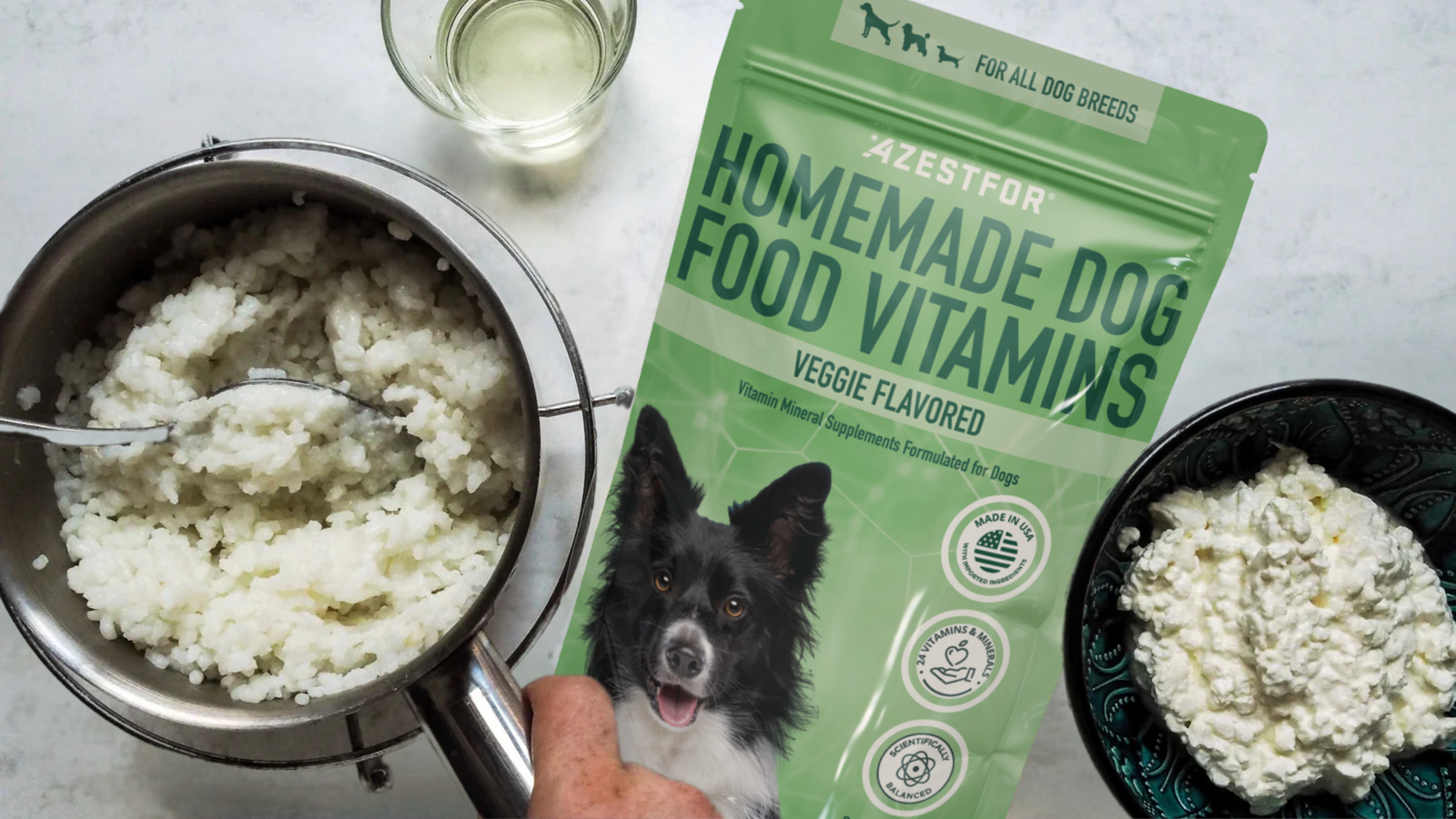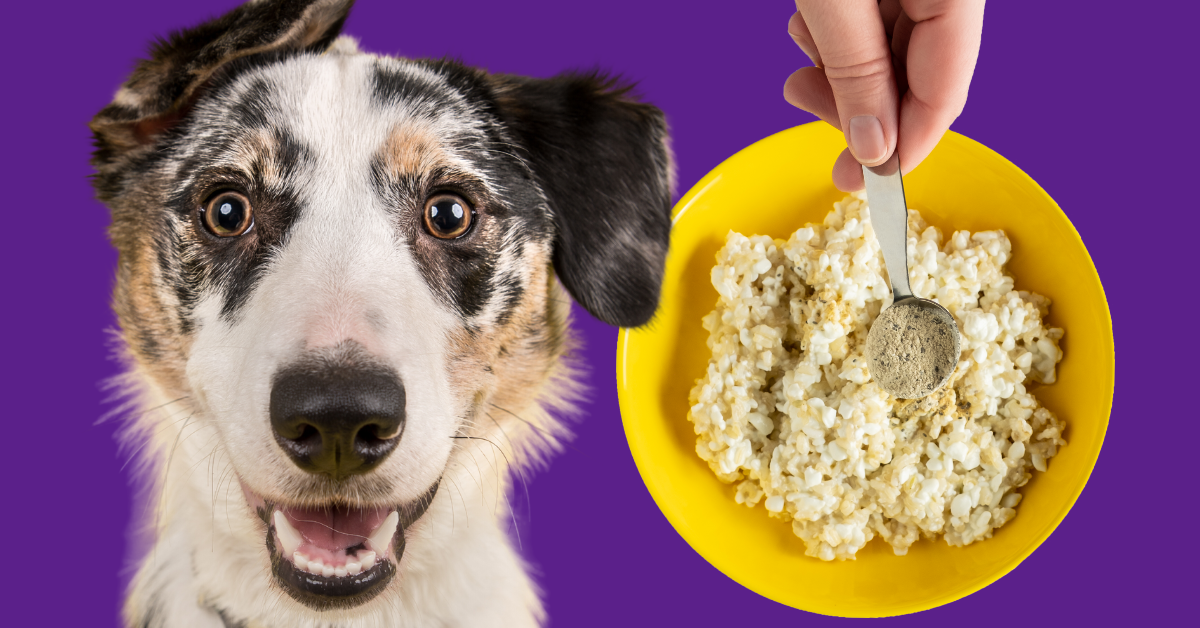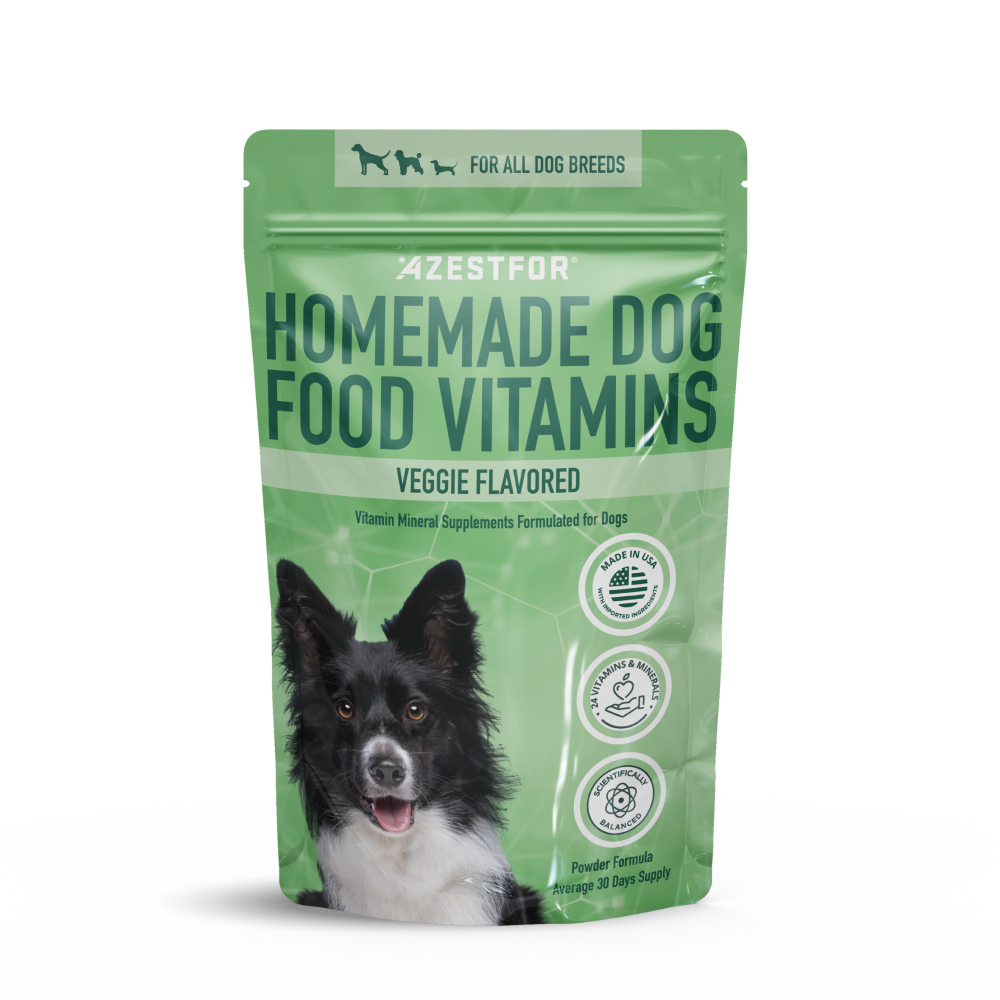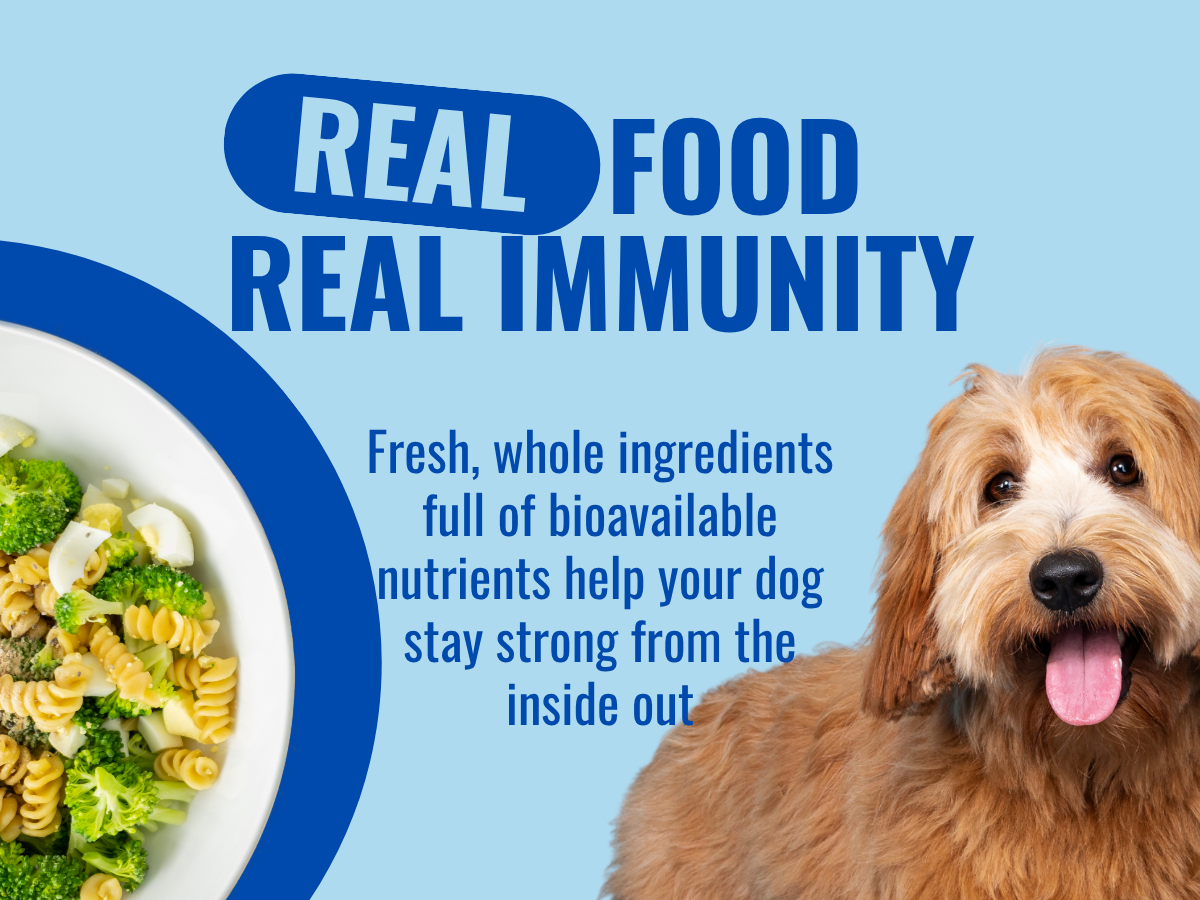Cottage Cheese & Rice For Dogs
INGREDIENTS
1 cup cottage cheese (plain, full fat)
1 cup long grain white rice,cooked
1 teaspoon sunflower oil
4 teaspoons Azestfor Vitamins
Prep Time: 3 minutes
Cook Time: 20 minutes
Servings: 2
Yield
This recipe will yield approximately 2 cups of food. Equating to 603 calories (Kcals) Approximately enough servings of food for one day for a 25 lb dog to maintain weight.
PROTEIN: 24.59%
FAT: 10.36%
CARBS: 57.94%
OTHER: 7.11%
Even the full fat version of cottage cheese is a low fat dog food alternative for the health conscience or vegetarian pet parent hoping to avoid meat, poultry and fish. This cheap homemade dog food recipe is also one of the easiest to prepare at home.
Preparing rice and cottage cheese for your dog

STEP 1
Cottage Cheese for Dogs
Set aside one cup of plain, full fat cottage cheese.

STEP 2
Cooking Rice for Dogs
Long grain white rice is preferred over quick cooking, instant rice in this recipe because it provides more nutritional value. If you do not have long grain white rice - instant is still ok. Brown rice is not suggested for this recipe if your dog is experiencing an upset stomach because it is harder to digest. Place white rice in a saucepan with double the amount of water. Bring to a boil, then turn the heat all the way down and cover the pan tightly with a lid. Cook on the lowest heat possible, for 10-15 minutes without uncovering the pot. Use a fork to fluff up the cooked rice, and set aside to cool.

STEP 3
Mix in sunflower oil
Sunflower oil is added as a source of linoleic acid (good for heart health and cholesterol levels). If you would like a substitute oil, you can add Wheat germ, Walnut or Corn oil in the ratio of 1.2 per 1 teaspoon of sunflower oil.

STEP 4
Add multivitamins
When the rice is cool to touch you can add Azestfor Vitamin Mix for homemade dog food.
Watch how to cook this rice and cottage cheese recipe for your dog:
This vegetarian dog food recipe is simple to prepare and gentle on your pup’s digestion with only three bland ingredients - perfect for a sensitive stomach. Cottage cheese is an excellent protein alternative to offer a dog allergic to chicken, beef, or fish.
This recipe is often used on a dog elimination diet for allergies. To learn more about how to detect and treat food allergies, as well as how to conduct your own controlled elimination diet:
Free Guide
Food Allergies In Dogs
If you are reviewing this homemade dog food for allergies recipe - because your dog has allergies grab a copy of this free Food Allergies in Dogs Guide
FAQs
Yes a dog can eat Cottage Cheese. Cottage cheese has a high biological value meaning it's easily absorbed and utilized by the body. Most dogs tolerate cottage cheese well, and allergies to milk proteins are relatively rare in dogs. Choose plain 1% fat, Avoid varieties with added salt, herb or seasonings.
Yes - It is a good source single-source of protein for dogs, especially as part of a controlled diet. It is rich in high-quality protein and low in fat.
- Rest the stomach - It is perfectly normal for dogs to self regulate and occasionally skip a meal. If your dog is generally healthy with no underlying medical conditions, and is vomiting or experiencing diarrhea, give your dog’s stomach a rest and allow him to skip a meal.
- Provide access to fresh water -While your dog isn’t eating, make sure there is plenty of access to water to prevent dehydration.
- A little pepto bismol or imodium may also help (dose according to your dog’s weight).
- After your pet’s missed meal, try to stimulate his appetite by offering a bland sick diet for dogs like homemade chicken and rice (substitute the brown rice in this recipe for White Rice because it is easier on digestion). We understand how challenging it can be for pet parents to know what to feed a sick dog with an upset stomach keeping the diet simple will help.
- Dogs have an incredible sense of smell and typically the aroma of a home cooked meal alone will be enough to get a dog who wasn’t eating previously to start nibbling again. Make sure the food is cool to the touch prior to serving, and not hot.
If an underlying health condition has been ruled out, and your dog continues to suffer from chronic diarrhea, it may be time to consider a dog elimination diet for allergies.
We have an excellent 8-page reference for you to download about how to detect and treat dog food allergies, as well as how to conduct a controlled elimination diet.
Definitely! If you already know your dog is allergic to chicken or beef, cottage cheese is a great alternative protein that is easy to digest and low in fat. Scroll up to the top of this page for info on how to prepare this simple and cheap homemade dog food recipe.
Yes. Serving a homemade dog food recipe with white rice can ease a dog’s sensitive stomach by aiding digestion and stopping diarrhea. As a carbohydrate, white rice also helps provide energy and can even lower cholesterol for your pup.
Many dog owners wonder if adding meat and providing fewer carbs is a more natural dietary choice for dogs due to their evolutionary connection with wolves. This seems completely logical. However, as dogs co-evolved with humans on farms, they began to eat less like their wolf ancestors, and more like their new best friends, as starchy human table scraps like potatoes and rice made their way into the canine diet.
Because white rice is so easily digested by dogs, it can also put weight on rather quickly if portion size is not controlled. In addition, white rice is high on the glycemic index, so consider carbohydrate alternatives like quinoa, peas, beans or lentils if your dog is diabetic.
If your dog won’t eat his food, you can put some into your hand to try hand feeding your dog, or even pretend to eat the food yourself because dogs are often curious about what their humans are eating. If your dog refuses to eat, simply pick up the food after an appropriate time (i.e. 15 minutes), and store it in the refrigerator. Present the food again at the next scheduled feeding time.
Do not offer a perceived higher value food to the dog like a treat if he isn’t eating. If you feed your dog treats after he refuses food, he is training you.
A dog’s motivation and desire to eat is often closely related to his or her body’s energetic needs, so try a little exercise. Play a rousing game of fetch, take your dog swimming, or try a long walk to see if it stimulates his appetite.
You can try adding 1 tablespoon of plain, canned pumpkin to your dog’s next meal. CLICK HERE for more suggestions.
If symptoms persist for over 48 hours, it’s likely a prescription is needed.
Tips for Serving Azestfor Vitamins
To ensure your pet is getting the most nutrition possible from his or her dog food supplement powder, remember these tips:
- Heat destroys the potency of vitamins
- A fully cooked recipe with vitamins mixed in, CAN BE FROZEN for up to one year from the cook date. This will not affect supplement potency.
- If you prefer to add your vitamins just before serving, add 1-1/4 teaspoons of Azestfor homemade dog food vitamins per 1 cup of homemade dog food.
How much rice and cottage cheese to feed your dog?
Feeding Guidelines:
We suggest dividing the daily amount into two servings, one in the morning and one in the evening. Every dog’s nutritional requirements are a little bit different due to age & amount of exercise. If your dog is losing weight, increase food by 1/4 cup a day, if they are gaining weight, reduce accordingly.
Weight of Dog Amount of Food to Feed to Maintain Weight
5 lbs - 2/3 cup per day
10 lbs - 1 cup per day
15 lbs - 1 1/2 cups per day
20 lbs - 2 cups per day
30 lbs - 2 1/2 cups per day
40 lbs - 3 cups per day
50 lbs - 4 cups per day
60 lbs - 4 1/3 cups per day
70 lbs - 5 cups per day
80 lbs - 5 1/4 cups per day
90 lbs - 6 cups per day








